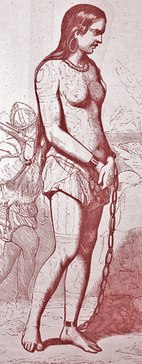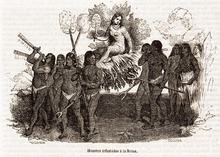|
Anacaona
Anacaona (1474?–1504), or Golden Flower, was a Taíno cacica, or female cacique (chief), religious expert, poet[citation needed] and composer[citation needed] born in Xaragua.[2] Before the arrival of Christopher Columbus in 1492, Ayiti or Quisqueya to the Taínos (the Spaniards named it La Española, i.e., Hispaniola — now known as the Dominican Republic and Haiti) was divided into five kingdoms, i.e., Xaragua, Maguana, Higüey, Maguá, and Marién. Anacaona was born into a family of caciques. She was the sister of Bohechío, the ruler of Xaragua.[3] She succeeded Bohechío as cacica after his death.[4] In 1503, Nicolás Ovando, the governor of the island, visited Xaragua. He suspected an insurrection was brewing among the Taíno chiefs, including Anacaona, presently in the kingdom.[4] Ovando gave the order for the caciques to be captured and burned. Anacaona was hanged.[4][5] Early life and familyAnacaona was born in Yaguana (present-day Léogâne, Haiti),[1] the capital of Jaragua,[6] in 1474 (?). Her name was derived from the Taíno words ana, meaning 'flower', and caona, meaning 'gold, golden.'[3] Anacaona's brother Bohechío was a local chieftain. He extended his rule in 1475 to include all territories west of Xaragua. Through consolidation of his influence and power, Bohechío married Anacaona to Caonabo, cacique of Maguana.[7] Together they had one daughter, Higüemota. On December 4, 1492,[8] Christopher Columbus arrived in the kingdom of Marién at present-day Mole St Nicholas, Haiti.[9] He was in search of a direct route to the Indies (India). Upon arrival, he was greeted by the Tainos, who were much smaller in stature compared to the Spaniards. Columbus was gifted with gold, corn, and other items. In 1493, the Spanish Crown established a colony whose sole purpose was to excavate for gold and other precious metals. With the establishment of the new colony Santo Domingo, the Taíno were kidnapped and enslaved to satisfy the needs of the Crown (many Taíno women were raped and those Taínos who resisted the Spaniards were murdered).[3][7][10] In 1493, Caonabo was arrested for ordering the destruction of La Navidad (a Spanish colony in the northwestern part of the island) and its people.[7] He was shipped to Spain and died in a shipwreck during the journey.[11] When Caonabo was captured, Anacaona returned to Xaragua and served as an advisor to Bohechío.[4] In 1498, Bohechío was confronted by Bartholomew Columbus, brother of Christopher Columbus and founder of the city of Santo Domingo, who arrived in Xaragua with his troops to subdue Bohechío and conquer his territory. The purpose of the Spaniards in so doing was to acquire gold. With his power weakened, Bohechío, advised by Anacaona, decided to recognize the sovereignty of the Catholic Monarchs. Instead of fighting, he committed himself to pay the tribute levied by the Spaniards with products such as cotton, bread, corn, and fish. Bohechío died before 1503 and Anacaona succeeded him and ruled as cacica.[12][4]   Arrest and death In the fall of 1503, Governor Nicolás Ovando and his party of 300 traveled on foot to Xaragua.[13] They were received in a lavish ceremony by Anacaona, her nobles, and several Taíno chiefs.[13] While the Taíno presented the reception as a gesture of welcome, the Spanish saw it as being an elaborate distraction.[11][14] Ovando's party was under the impression that Anacaona and the Taíno chiefs present at the reception were planning an insurrection.[11] Ovando lured the chiefs into a caney (large hut) for a Spanish tournament and gave the signal for the Spaniards to seize and bind the caciques.[13] They were burned in the caney while other Taínos of lower rank were slaughtered outside. Anacaona was hanged.[4][14] Or Anacaona was transferred to Santo Domingo in 1504, and three months later, she was tried and sentenced to death by hanging.[15] According to historian Troy S. Floyd, the accuracy of the accounts of this event remain uncertain for many reasons.[14] For one, even though the separate accounts made it seem as though it was a perfectly segregated fight along racial lines, the two groups had coexisted and intermarried for six years prior.[14] For another, it is unclear why the Spaniards would lure the Taínos into a trap.[14] However, there was a history of violence where the Taíno were kidnapped and enslaved to satisfy the needs of the Crown (many Taíno women were raped and those Taínos who resisted the Spaniards were murdered). [16][7][17] Additionally, fifty Spaniards were killed;[14] this is a high number of casualties considering that the Europeans deployed superior military technology. Finally, the Xaragua caciques were respected as some of the most intelligent on the island and it is unlikely that they could be lured into a hut if they were planning their own revolt.[14][13] According to Sir Arthur Helps' book The Spanish Conquest in America (1855), Nicolás Ovando renamed the place where Anacaona was murdered “The City of True Peace” (La Villa de la Vera Paz), "...in honor of his recent triumph". The arms assigned to the city were "...a rainbow and a cross, with a dove bearing the olive branch!". Legacy and influenceAnacaona, as a poet and composer, is accordingly memorialized in contemporary art and literature across the Caribbean region.[18] A statue commemorating her legacy is in Léogâne, Haiti. The tallest building in the Caribbean, Torre Anacaona 27, is named after her, in the Dominican Republic. The song Anacaona, lead vocals by Cheo Feliciano, popularizes her story.[19] Literature
Music
See also
Notes
References
Attribution
External links
|
||||||||||||||||||||||
